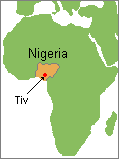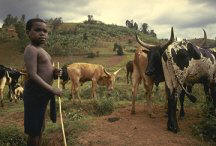Introduction
There are vast differences between the economies
of isolated, small, self-sufficient societies and large-scale ones that are
integrated into the modern system of global commerce.
These differences are not only in terms of the scale of the economies.
Their systems of production, distribution, and exchange as well as concepts
of property ownership are often radically different.
Systems of production refer to how food and other necessities are produced. In other words, they are the subsistence patterns discussed in the last tutorial of this series--i.e., foraging, pastoralism, horticulture, and intensive agriculture. Systems of distribution and exchange refer to the practices that are involved in getting the goods and services produced by a society to its people. Regardless of the type of subsistence base, all societies need to have mechanisms of distribution and exchange. These mechanisms, along with ownership concepts, are the focus of this tutorial.
All of the large-scale societies of the world today have market economies. These are very impersonal but highly efficient systems of production, distribution, and exchange that are principally characterized by:
| 1. | the use of money as a means of exchange |
| 2. | having the ability to accumulate vast amounts of capital (i.e., wealth that can be used to fund further production) |
| 3. | having complex economic interactions that are ultimately international in scale |
 |
|
|
How difficult
could it be |
|
A trip to buy a loaf of bread in an American supermarket typifies the nature of market exchanges. An individual who speaks no English and who is a total stranger to all of the people in the store can walk in, look around without any assistance, and find the bread. Taking it to the check-out stand, the price is registered automatically with a bar code reader and appears on the cash register display screen. Without saying a word, the purchaser can hand over the money, pick up the bread, which is usually now in a plastic bag, and walk out of the store. The exchange is quick, efficient, and did not require talking. The purchaser did not need to personally know the people working in the store, the baker, the miller, the farmer who produced the wheat, or the truck drivers who carried the product from one stage of production to another and ultimately to the point of distribution. Likewise, the purchaser did not need to even think about the fact that the plastic bag that enclosed the loaf of bread was created mostly out of petrochemicals that very likely started out as crude oil on the other side of the planet. Likewise, the money that was given in exchange for the bread was made with machinery that was created out of a number of different materials that probably were acquired from several different countries. On close examination, almost any simple market exchange involves the interaction of people all over the world and elaborate technology used in production and distribution.
This kind of complex market exchange system does not usually exist in small, isolated economies, such as those of indigenous foragers, small-scale horticulturalists, and nomadic pastoralists. These societies rarely use money and most people produce their own necessities. Their very different non-market economies are described in the next section of this tutorial.
What is Money?
|
|
|
| General purpose money in the United States |
|
Before exploring the nature of non-market economies, it is of value to compare the two broad types of money that people have used around the world. Anthropologists refer to them as general purpose and special purpose money.
General purpose money is a portable, arbitrarily valued medium of exchange. All market economies today use this form of money. It can have a variety of physical forms--e.g., coins, paper money, or bank checks. It can also be simply a digital transmission from one computer to another that occurs with the use of credit cards or the electronic transfer of funds. The key point about general purpose money is that anything that is for sale can be bought with it--everyone accepts it. General purpose money is also referred to as "standardized currency."
|
|
Special purpose money consists of objects that
serve as a medium of exchange in only limited contexts. In societies
that have it, usually there are certain goods and services that can be
purchased only with their specific form of special purpose money. If you
don't have it, you cannot acquire the things that it can purchase.
You may not be able to easily obtain the special purpose money either.
The Tiv
![]() people of central Nigeria provide an example. In the past, they
used brass rods to buy cattle and to pay bride price.
These rods were acquired by trade from Sahara Desert tribes who ultimately
obtained them from the urbanized societies of North Africa. If a man
could not acquire brass rods by trade or borrowing them, he would be prevented
from acquiring cattle and getting married. This was potentially a
critical problem because having wives and cattle
identified a man as being important and worthy of respect.
people of central Nigeria provide an example. In the past, they
used brass rods to buy cattle and to pay bride price.
These rods were acquired by trade from Sahara Desert tribes who ultimately
obtained them from the urbanized societies of North Africa. If a man
could not acquire brass rods by trade or borrowing them, he would be prevented
from acquiring cattle and getting married. This was potentially a
critical problem because having wives and cattle
identified a man as being important and worthy of respect.
|
|
|
|
Cattle--a form of special
purpose |
|
Traditional pastoralists commonly measure wealth in terms of numbers of livestock. In a very real sense, their animals are their form of special purpose money. They usually make exact equivalences in terms of relative value--e.g., so many sheep equal so many head of cattle which in turn equal the cost of a gun or something else of value. If a man does not have livestock in such societies, he usually cannot trade for high prestige items nor can he get married since animals must be given as the bride price. Using animals as currency has distinct disadvantages and advantages. Animals can die of diseases and must be actively cared for and guarded. This makes herding a risky business. On the other hand, animals reproduce so that an individual's wealth can grow rapidly. This is like getting a very high interest rate on money in a bank.
When general purpose money is introduced into an economy that previously only had special purpose money, the effect most often is dramatic for the social order. Among East African cattle herding cultures, it is now possible for a young man to get a job outside of his local community and to earn general purpose money. In these pastoralist societies in the past, young men had little hope of obtaining wealth before they were in their early middle age. They usually had to delay marriage for years because of the inability to accumulate a sufficient number of cattle to pay a bride price. Typically, a man in his late 20's or early 30's had to obtain a loan of cattle from elder men in his family for this purpose. The continuing obligation to pay off such loans reinforced the traditional authority of older men and the dependence of younger men. Now it is possible for a young man to accumulate enough general purpose money to purchase cattle and bring them back to his tribal homeland. He can then use them to pay a bride price. As a result, he will not be in financial debt to his elder kinsmen. The result is greater economic independence for young men. This is likely to be seen as good from the perspective of democratic, achievement oriented cultures, such as those of North America and Europe. However, from the perspective of the pastoralist societies in which these changes are occurring, it can be seen as being bad because it undermines the traditional authority of elders. This authority has been a key part of their cultural value system. A major concern of these societies often is that erosion of the value system will result in social chaos and the destruction of their traditional culture.
It is clear that the introduction of general purpose money has had a powerful effect on previously isolated small-scale societies. It facilitates trade and gives individuals the ability to accumulate wealth. Paradoxically, however, as the use of general purpose money draws a society into the global economic system, it does not result in economic independence for the society as a whole. In fact, it usually results in less self-sufficiency.
This page was last updated on
Friday, June 23, 2006.
Copyright 2003-2006 by Dennis
O'Neil. All rights reserved.
Illustration credits


